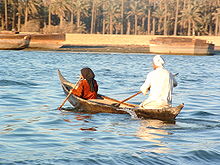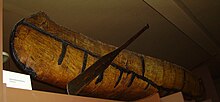canoe

A canoe is a boat that is moved with paddles in the direction of view, also called a paddle boat . The main types are kayaks and Canadians . In contrast, rowing boats are usually rowed with their backs facing the direction of travel. In rowing boats the scull or the strap is connected to the hull ( oarlock ), while in a canoe the paddles are guided freely.
term
The term can be traced back to a Germanization of English canoe at the end of the 19th century, when canoeists from Great Britain were increasingly on the move in continental Europe. The oldest German canoe club , the Alster Canoe Club from Hamburg , founded in 1905 , continues to use the traditional spelling Canoe in its name.
In British English , as in German , canoe is understood as a generic term and Canadians are referred to as open canoe , Canadian canoe or Indian canoe . In American English, on the other hand, canoe refers to a Canadian, like the French canoë. The Canoeing in French Canoe-Kayak .
First, Christopher Columbus used the phrase of the Caribbean arawak . Inca Garcilaso de la Vega defined it as an open boat. The English then used the term for all Indian boats . The term Canadian in Europe arose from a misunderstanding when the Open Canadian Style canoe from Canada , the open canoe recognized by the American Canoe Association at the time , was seen as representative of all canoes. The Maine canoe made of wood and cloth , which was not recognized until 1934, was then also referred to as the Canadian.
history


Dugout finds from 6000 to 4000 BC There are in Scotland . The origin of the canoe is dated to around 4000 BC. A primeval canoe about this age was also found on the Euphrates . However, the dugout canoe is not a direct ancestor of today's canoeing boats. Kayaks, Canadians and collapsible boats have been developed from the skin boats of the Eskimos and the bark boats of the North American Indians. The first versions consisted of animal skin and bones or birch bark or wood . Folding boats also consist of an inner frame with covering and are available as kayaks as well as folding canoes . Some inflatables are counted among the canoes.
The kayaks (originally always covered canoes, so due to their design, canoes closed at the top) come from the Inuit , like the umiaks , and the Canadians from the [natives of North America]. Dragon boats come from Asia , outrigger canoes , waka and pirogues from the South Seas .
designation
The driver of a canoe is called a paddler or canoeist . Kayaks are moved while sitting with a double paddle and Canadians, depending on the type and area of use, while sitting or kneeling with a paddle .

Designs
A rough distinction is made between kayaks with a closed deck and seat hatch (s) and the traditionally open Canadians . This distinction applies above all to touring boats, but also to competition boats in canoe racing and canoe marathons . In canoe slalom , white water racing and freestyle , it is sometimes difficult to distinguish a kayak from a Canadian, as Canadians can have a closed deck here too. While kayaks are always ridden sitting down, you usually kneel due to the better power transmission in a Canoe. In whitewater canoes, saddle seats or so-called "bulkheads" are used for better boat control and weight distribution. Additionally, knee or thigh straps attached to the boat ensure that the boat without bulkhead does not lose hold of the boat even in extreme driving situations. Bulkheads, on the other hand, perfectly fit the thighs of a paddler with closed-cell foam. Even in an open canoe, it is possible to roll an Eskimo to straighten the overturned boat. In canoe racing and canoe marathon (in the European form of competition) the paddler kneels on one knee, the other is upright. These boats often do not have a seat at all. Touring Canadians are often paddled sitting down, as the kneeling position (crouching on the front edge of the seat, feet pushed under the seat) takes some getting used to. However, the kneeling position offers better boat control, better power transfer and more freedom of movement, so it is often preferred by more experienced paddlers. Some boat builders take this into account by using seats that are lowered at the leading edge to facilitate the kneeling position.
An intermediate form is the Baidarka , which can be driven kneeling with paddle paddles as well as sitting with double paddles.
The main characteristics of the driving characteristics of canoes are speed, maneuverability and tipping stability. Today we know a variety of boat shapes , boat classes and disciplines in canoeing . Canadians are often more stable than kayaks, often tolerate a higher payload than kayaks and are easy to load or allow paddlers to get on and off more easily. Depending on the shape and paddling technique, Canadians do not have to be slower or less agile than kayaks.
The punt is a special form of canoe . Originally, punts were made of wood and moved by pegs. This is where the name comes from (the English verb "punt" means to stake in German). The floor plan resembles a rectangle. The stern is covered. Today this type of canoe can mainly be found in the Spreewald.
Today kayaks and Canadians are mainly made of GRP , PE , Royalex (no longer in production since the end of 2013), PVC and aluminum , and more rarely also from wood or as a textile or leather-covered frame construction made from willow , reed or even bone .

